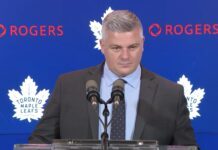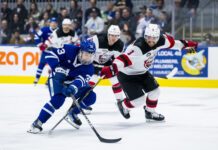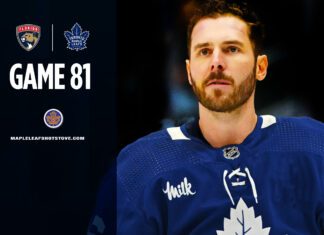So I wanted to try and bridge the many events of the Leafs off-season into a giant post – unfortunately, after I get one of the topics off my chest, I am probably going to wing this (sorry Alec). I haven’t had the time to really break down my own thoughts because my summer has been all about being as lazy as I could possibly be – I’m a little surprised that I haven’t gone a day without taking a shower yet. So I hope everyone is enjoying their summer, getting sun, and trying out new beer.
Scoring Chances, Being a Douchebag, and Circle Jerkin’
At the end of the Leafs season, there were some questions about the path management would take to improve the possession weakness that had plagued the organization all season long. By any metric available to the public, the Leafs were soundly out-shot, out-possessed – this is indisputable by shots taken, shots attempted, and in the recorded cases, puck possession time.
In perhaps one of the greatest hockey interviews ever by our own Alec Brownscombe, Leafs assistant coach Greg Cronin declared that he did not believe that the team was out-possessed at all. Skepticism aside, it did give the fan-base some clue of what the team tracked as far possession was concerned – scoring chances. I took a quick look at Cam Charron’s scoring chance work throughout the season, but couldn’t find anything beyond 36 games. But at the 36 game mark, the Leafs did actually out-chance their opponents 474-469. Edit: I erred on my interpretation of these numbers — the original included special teams. The actual numbers available to us are 392 against and 355 for on even-strength. However, this isn’t the chasm inferred via shots total against. But it does leave me wondering what Cam’s final scoring chance counter was.
The Leafs out-chancing the opposition doesn’t necessarily mean anything. But it does give credence that the coaching staff actually knows what they want out of their line-up, how to get it, and what they are tracking. Oddly enough, the narrative that Carlyle and Co. don’t have a clue what they are doing come from the lowest denominator of an internet arm-chair general manager from that other place. You might get a good look here and wonder why SkinnyPPPhish has difficulties understanding that Ben Scrivens’ save percentage was well below the league average from 10 and 20 feet out while improving as the shots were pushed out. This was repeatedly pointed out, but I guess this is a last resort to draw attention to less circle-jerkin’ in a comment section and more open-mindedness about the devil in the details.
And by the way, James Reimer was above the league average for save percentage in the 10 and 20 feet distances, which kind of busts the myth the goals given up were a little high. In fact, if you consider the shots given up with Reimer in net in the 10 and 20 feet area of the ice, he was slightly below the league average of roughly 6.974 shots per game – he took 6.94 whereas Scrivens took 5.5 per game and gave up 20 goals. So the evidence clearly points to Scrivens being less than stellar with handling scoring chances while Reimer was significantly above league average.
Now, I wanted to actually find out what exactly the scoring chances were against Reimer and Scrivens. Thanks to Greg Sinclair, I went to check www.somekindofninja.com to check out the scoring chance data we have available. As some of you know, the blogging community has explored the scoring chance data by using a home-plate area of the ice just in front of the net. Sinclair’s site has added the home-plate area search feature to our benefit:
James Reimer: 34 goals, 262 shots: .870%
Ben Scrivens: 25 goals, 128 shots: .805%
At this point, I think we can quickly bust whatever point SkinnyPPPhish was trying to make with his super fancy stats, pie charts and tables, general douchebaggery, and move on with our lives. Scriven’s scoring chance performance at even strength was abysmal – his performance is likely why the Leafs went ahead to acquire Jonathan Bernier (as well as insurance against a Reimer injury). While it’s not entirely fair to throw the Leafs’ short-comings at one player’s feet, Scrivens did have a rough season.
If a skeptic wants my data, I can provide the excel spreadsheet via email – just tweet or DM me on Twitter and I’ll fire off the attachment.
All told, I am going to undertake a project on my own to track scoring chances this coming season. Just for the Leafs and their opponents – I’m going to also try and locate who was on the ice at the time of the scoring chance and see where it takes me. Here’s a great refresher on the definition of a scoring chance.
I will get into more details once I have it mapped out for the season.
Miscellaneous
The re-signing of Tyler Bozak is extremely questionable to me. On one hand, it is so goddamn tiring to have mediocre centre options on the first line. I want a bona-fide number one centre who can dish the puck, shoot the puck, and make life a living hell for opponents with Kessel and van Reimsdyk flying down the wing playing shotgun. Bozak is nothing close to creative or even a good possession player – but he does defend with good effort and the face-offs do have some value to the line. I do hope that he can continue refining and expanding his game, but he’s going to have to be a little more selfish about shooting when he has the opportunity to.
Bozak’s contract is listed at 5-years / $22,000,000. On the surface, it’s terrible. Long-term, I don’t anticipate an issue. James Mirte did some conservative research on the rising cap. While the numbers are low, it’s entirely possible that within a few years, Bozak’s contract would fall into the middle or lower-tiers of a second line centre – perhaps even a third-liner. Whatever the future may be, I think it’s safe to say that it’s not the horrid contract some have purported it to be.
Conversely, the Clarkson signing is extremely intriguing and very worrying. The Leafs were already dealing with a bevy of talent on the wing, but adding Clarkson to the mix only makes them even more versatile. The Leafs can bring a speed game, a skill game, or a physical game. And it’s nice to have a player who can play hockey and throw down with some fists.
However, 7-years / $36,500,000 for a power-forward who will soon be on the downswing of his production is just too much. There’s some hope that he can sustain some sort of productivity in the later stages of his contract, but it appears to be a three or four year investment. My big hope is that Clarkson brings the possession game that many on social media have demanded – at the very least, the Leafs might not win a game next year, but at least their Corsi and Fenwicks are positive and we can all pat ourselves on each other’s backs and say, “We did It, guys! We have positive Corsi!”
For the record, I am really pleased with Carl Gunnarsson’s re-signing and the contract. A very underrated player and I hope his hip issues are behind him. As for Paul Ranger, whatever personal issues have plagued him in the last four years, I hope he’s ready and committed to helping shore up the team’s defense.
The Leafs have some three remaining RFAs to re-sign. Nazem Kadri, Cody Franson, and Mark Fraser are the three. I’m actually not that concerned about Nonis and Co.’s ability to re-sign all three since I anticipate that J.M. Liles will be traded anyway – but if Franson or Kadri are traded, all bets are off. My guess is that Fraser will be awarded less than 1M, Franson 3.1M, and Kadri 3.5M – all will be given a bridge contract.
I have a lot of faith in Kadri’s abilities and I hope that his ceiling comes sooner rather than later – the team needs his skill on the first line and I hope he’s up to the task.
More stuff coming later – someone will add links to the post. I’m off for a week. I will try and get more content up when I get back. Enjoy your weekend!
Links:
Lupul misses the Canadian Men’s Olympic hockey try-out — aims to improve



































